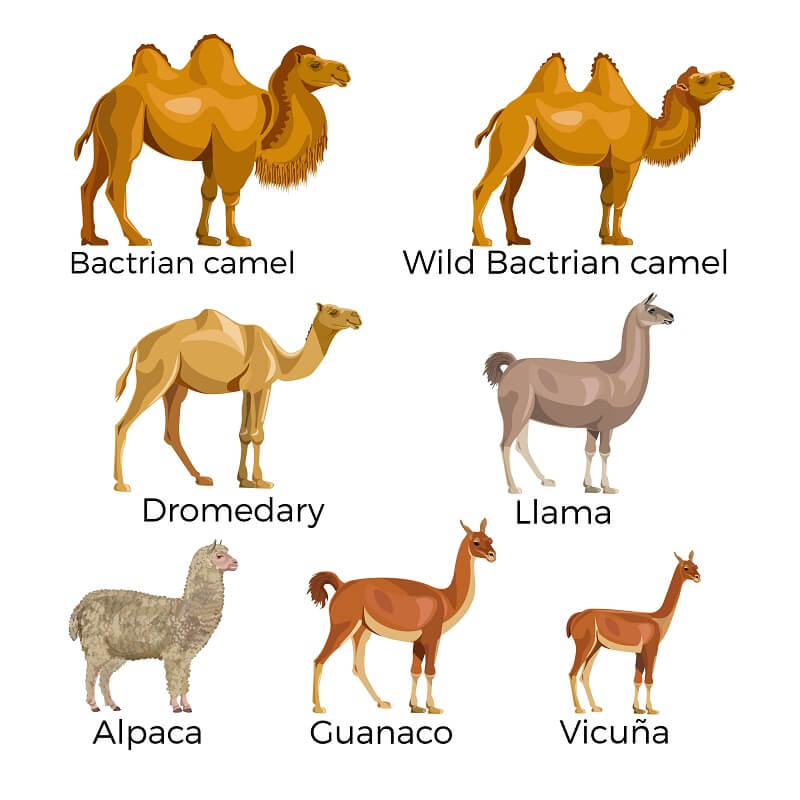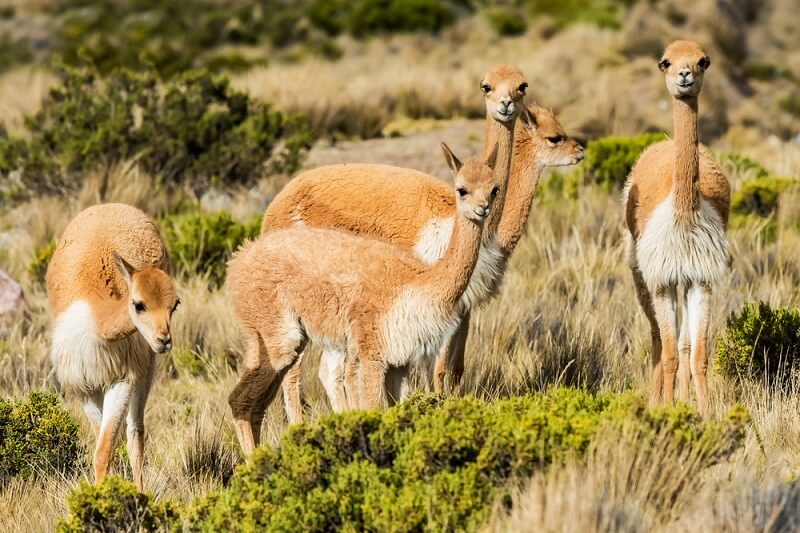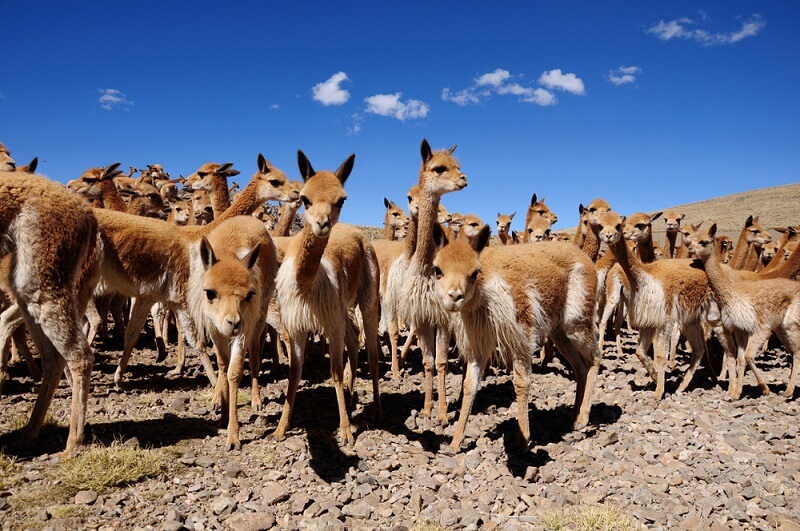
The vicuña (pronounced ve-coon-ah) is a species native to the Andes mountain, closely related to the guanaco. The vicuña is part of the camel family, though it is by far the smallest member. Compared to a guanaco, the vicuña is only about half the size, has a smaller tail, and finer wool. Domestic alpacas are likely to have originated from ancient vinuña domestication attempts. Vicuñas occupy the grasslands of the central Andes mountains and are adapted to very high elevations. In fact, most vicuñas are found between 10,000 and 15,000 feet – higher than most mountains in many parts of the world. They spend their days feeding throughout the grassy plains. At night, the herds move back into the hills. In the hills and mountainous regions, vicuñas are able to avoid many of their predators. They are very nimble along rocky ridges, allowing them to evade less agile predators. However, pumas are a major predator of vicuñas, and pumas are more than capable of capturing prey among unsure footing. The fiber produced by the vicuña is extremely valuable because of its extremely soft and warm nature. Individual wool fibers are some of the finest in the animal kingdom – leading to one of the softest fabrics in creation when it is weaved together. The fabric is so expensive that a suit jacket made of vicuña wool can cost upwards of $20,000! The fibers are designed to keep the animal comfortable in the highly variable environment of the Andes Mountains. In the day, temperatures can be scorching hot. The light color and airiness of vicuña wool ensure that the animals do not overheat. Nighttime in the Andes is a different story, with temperatures often dropping below freezing. Hollow air pockets within the wool keep the organisms warm even in the face of freezing temperatures. Part of the reason that the vicuña was revered by ancient Inca civilization was because of its fine wool. Only Incan royalty was allowed to wear the wool, as a sign of status and respect. When the Spanish conquistadors invaded South America, vicuña wool was taken back to Europe and grew in popularity. Through centuries of unregulated harvesting, the vicuña was nearly extinct in the 1960s! The vicuña is a fascinating species because of its amazing adaptations, and in part because of the history humanity has experienced with the vicuña. While these are fascinating subjects, the vicuña also displays several important concepts that are important to all of biology! The conservation of vicuñas relies on a trick that can be useful to many other endangered species. In the 1970s, the Peruvian government and a number of non-profit organizations teamed up to prevent the vicuña from going extinct. To do so required the help of the community and a large number of wool shears. Every few years, the community gathers in the national park to round up all of the vicuñas. Slowly and surely, hundreds or thousands of vicuñas are rounded up into pens. The vicuñas are captured, shaved, and returned to the wild unharmed. This process removes the valuable wool from the animals – removing the value poachers see in the animals. This event is known as a Chaccu – sort of like a vicuña rodeo! The sale of the wool benefits conservation efforts and the local community. This technique helped get the vicuña off of the endangered species list! Though there were as little as 6,000 vicuña in the 1960s, populations are now well above 350,000! Conservationists working on other species have started adopting this technique, with similar success. Rhinos and elephants in certain parks have their ivory tusks regularly shaved down, making the animals almost worthless to a poacher. Typically, if the valuable part of an animal can be removed without harm to the animal the method is perfect for reducing poaching. A variety of animals produces wool – from sheep to llamas – but not all wool is the same. Wool from different species can have many different qualities, including its width, length, growth time, and ability to trap air pockets. Vicuña wool is extremely fine and traps air wonderfully – but can take up to 2 years or more to grow out fully! Most wool-producing animals evolved in environments with severe temperature shifts. Wool traps heat when it is too cold and dissipates heat when things start getting too hot. This allows wool-producing animals to live in mountainous environments that have drastic temperature swings regularly. Wool is also covered in oils, which help keep animals dry when it rains heavily. The domestic wool-producing animals – sheep, llamas, goats, and some rabbits – have all been artificially selected to produce more wool, faster. While llamas and alpacas are closely related to vicuñas, they can produce far more wool because they have been selected for generations to do so. While this makes alpaca wool easier to obtain, this also makes vicuña wool more valuable because it is higher quality and harder to obtain.
Kingdom
Animalia
Phylum
Chordata
Class
Mammalia
Order
Artiodactyla
Family
Camelidae
Genus
Vicugna
Species
Vicugna vicugna
Niche
Herding Herbivore
Length
About 5 feet (1.5 m)
Weight
<150 lbs (35-60 kg)
Lifespan
15-20 years
Social Structure
Herds
Conservation Status
Least Concern
Preferred Habitat
Grassy plains, mountainous slopes
Average Number of Offspring
Typically 1 fawn
Main Prey Species
Grasses
Predators
Puma, Culpeo, Foxes
The Basics

Vicuña Wool – One of the World’s Most Expensive Fabrics!

Interesting Insights from the Vicuña!
Preventing Poaching – Shave the Vicuñas!

Wool-Producing Animals
